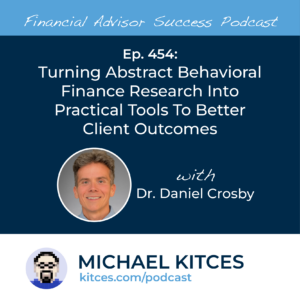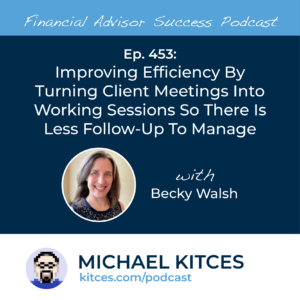 Welcome everyone! Welcome to the 454th episode of the Financial Advisor Success Podcast!
Welcome everyone! Welcome to the 454th episode of the Financial Advisor Success Podcast!
My guest on today's podcast is Dr. Daniel Crosby. Daniel is the Chief Behavioral Officer of Orion, an technology platform serving financial advisors.
What's unique about Daniel, though, is how he has turned abstract behavioral finance concepts into practical tools advisors can use to understand their clients' relationships with money and to help them set better goals.
In this episode, we talk in-depth about how Daniel helped develop a tool to analyze where individuals fall across five dimensions of one's money personality (spending today versus saving, directness of communication about money, worry about money, an individualistic versus collectivistic approach toward money, and the importance placed on money and wealth), why Daniel finds that there is a tendency for those on one end of the spectrum on a particular dimension to judge those on the other end (for example, a spouse who tends to be a saver might judge a more spendthrift spouse for not saving for the future, while the latter might think the saver's habits are limiting their enjoyment of today), and why Daniel ultimately finds that neither end of each dimension is necessarily superior (and how advisors can help clients identify potential blind spots if they fall at one extreme or the other).
We also talk about how Daniel has helped develop a tool that allows advisors to incorporate positive psychology principles into the planning process to better understand what makes clients flourish, how Daniel has clients rank the importance of six items related to flourishing (including leisure, work, relationships, meaning, personal growth, and physical health) and then rate themselves on how well they're doing on each item, and how Daniel finds that identifying divergences between these scores (for example, rating relationships as important but giving a low self-rating on it) can help advisors and clients identify potential financial goals that could lead to greater flourishing (for example setting aside money for a major family vacation).
And be certain to listen to the end, where Daniel shares why he thinks one of the best uses of behavioral finance for financial advisors is to take a step back and consider how their own attitudes towards money might influence how they communicate with clients, how Daniel finds that having an understanding of an advisor's own attitudes towards money can help advisors avoid coming across as judgmental (one of the key hurdles for individuals considering whether to approach an advisor) and ultimately lead to more and stronger client relationships, and why Daniel thinks that (beyond behavioral finance tools) the practice of listening carefully to clients can help advisors uncover the underlying reasons for clients' seemingly sub-optimal financial decisions and allow the advisor and client to move forward from a common understanding of where the client is coming from.
So, whether you're interested in learning about how Daniel turned complex behavioral concepts into usable advisor tools, including a "money personality" framework and a flourishing goals assessment, how identifying gaps between what clients value and how they feel they’re doing in life can spark more relevant financial goals, and why advisors must examine their own money beliefs and blind spots, then we hope you enjoy this episode of the Financial Advisor Success podcast, with Dr. Daniel Crosby.




